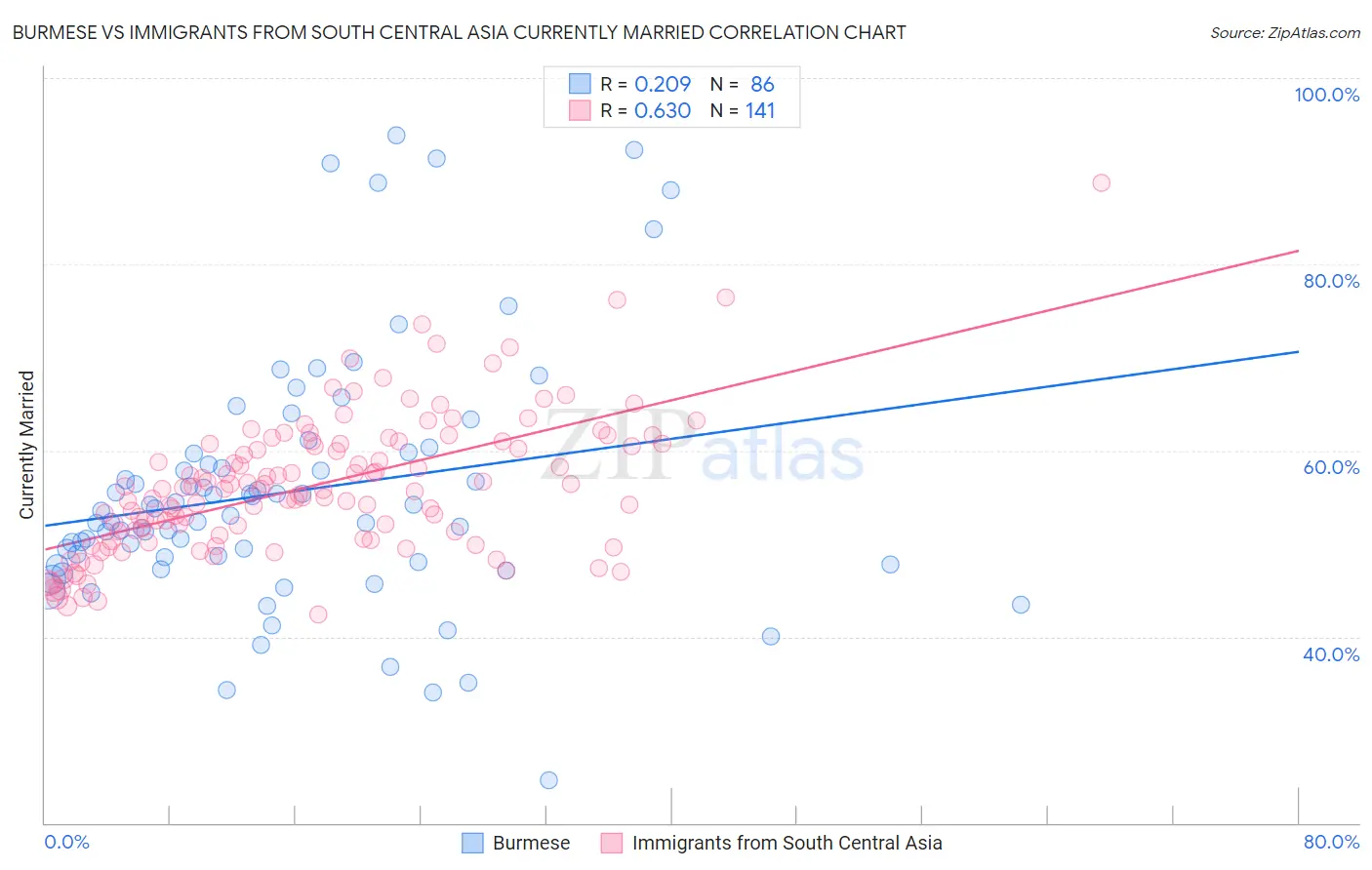Burmese vs Immigrants from South Central Asia Currently Married
COMPARE
Burmese
Immigrants from South Central Asia
Currently Married
Currently Married Comparison
Burmese
Immigrants from South Central Asia
48.9%
CURRENTLY MARRIED
99.6/ 100
METRIC RATING
27th/ 347
METRIC RANK
50.0%
CURRENTLY MARRIED
100.0/ 100
METRIC RATING
7th/ 347
METRIC RANK
Burmese vs Immigrants from South Central Asia Currently Married Correlation Chart
The statistical analysis conducted on geographies consisting of 465,297,934 people shows a weak positive correlation between the proportion of Burmese and percentage of population currently married in the United States with a correlation coefficient (R) of 0.209 and weighted average of 48.9%. Similarly, the statistical analysis conducted on geographies consisting of 473,021,987 people shows a significant positive correlation between the proportion of Immigrants from South Central Asia and percentage of population currently married in the United States with a correlation coefficient (R) of 0.630 and weighted average of 50.0%, a difference of 2.2%.

Currently Married Correlation Summary
| Measurement | Burmese | Immigrants from South Central Asia |
| Minimum | 24.6% | 42.4% |
| Maximum | 93.9% | 88.7% |
| Range | 69.3% | 46.3% |
| Mean | 55.6% | 56.2% |
| Median | 53.2% | 55.8% |
| Interquartile 25% (IQ1) | 48.0% | 50.7% |
| Interquartile 75% (IQ3) | 59.7% | 60.7% |
| Interquartile Range (IQR) | 11.7% | 10.0% |
| Standard Deviation (Sample) | 13.6% | 7.4% |
| Standard Deviation (Population) | 13.5% | 7.4% |
Demographics Similar to Burmese and Immigrants from South Central Asia by Currently Married
In terms of currently married, the demographic groups most similar to Burmese are Immigrants from Korea (49.0%, a difference of 0.070%), Maltese (49.0%, a difference of 0.12%), Lithuanian (49.0%, a difference of 0.13%), Immigrants from Pakistan (49.1%, a difference of 0.24%), and Bulgarian (49.1%, a difference of 0.35%). Similarly, the demographic groups most similar to Immigrants from South Central Asia are Swedish (50.0%, a difference of 0.13%), Czech (49.9%, a difference of 0.32%), Filipino (49.7%, a difference of 0.58%), English (49.7%, a difference of 0.59%), and Swiss (49.7%, a difference of 0.59%).
| Demographics | Rating | Rank | Currently Married |
| Immigrants | South Central Asia | 100.0 /100 | #7 | Exceptional 50.0% |
| Swedes | 100.0 /100 | #8 | Exceptional 50.0% |
| Czechs | 99.9 /100 | #9 | Exceptional 49.9% |
| Filipinos | 99.9 /100 | #10 | Exceptional 49.7% |
| English | 99.9 /100 | #11 | Exceptional 49.7% |
| Swiss | 99.9 /100 | #12 | Exceptional 49.7% |
| Dutch | 99.9 /100 | #13 | Exceptional 49.6% |
| Germans | 99.9 /100 | #14 | Exceptional 49.6% |
| Pennsylvania Germans | 99.9 /100 | #15 | Exceptional 49.6% |
| Chinese | 99.9 /100 | #16 | Exceptional 49.5% |
| Scandinavians | 99.9 /100 | #17 | Exceptional 49.5% |
| Immigrants | Scotland | 99.8 /100 | #18 | Exceptional 49.3% |
| Europeans | 99.8 /100 | #19 | Exceptional 49.3% |
| Luxembourgers | 99.8 /100 | #20 | Exceptional 49.3% |
| Scottish | 99.8 /100 | #21 | Exceptional 49.2% |
| Bulgarians | 99.7 /100 | #22 | Exceptional 49.1% |
| Immigrants | Pakistan | 99.7 /100 | #23 | Exceptional 49.1% |
| Lithuanians | 99.6 /100 | #24 | Exceptional 49.0% |
| Maltese | 99.6 /100 | #25 | Exceptional 49.0% |
| Immigrants | Korea | 99.6 /100 | #26 | Exceptional 49.0% |
| Burmese | 99.6 /100 | #27 | Exceptional 48.9% |